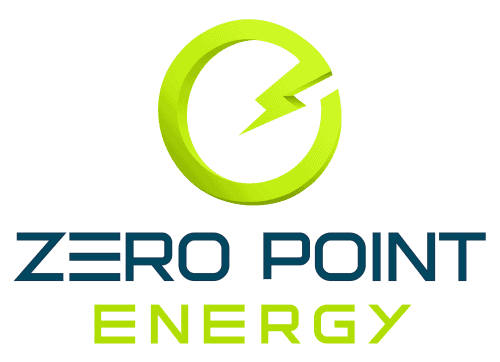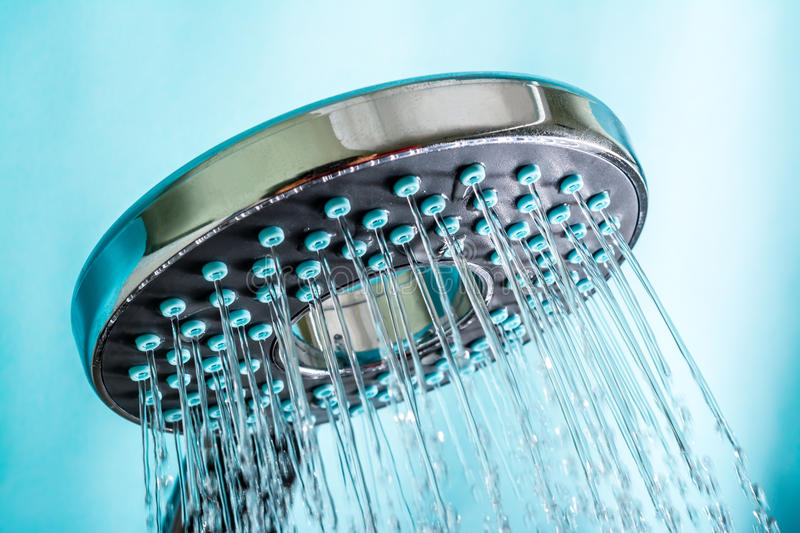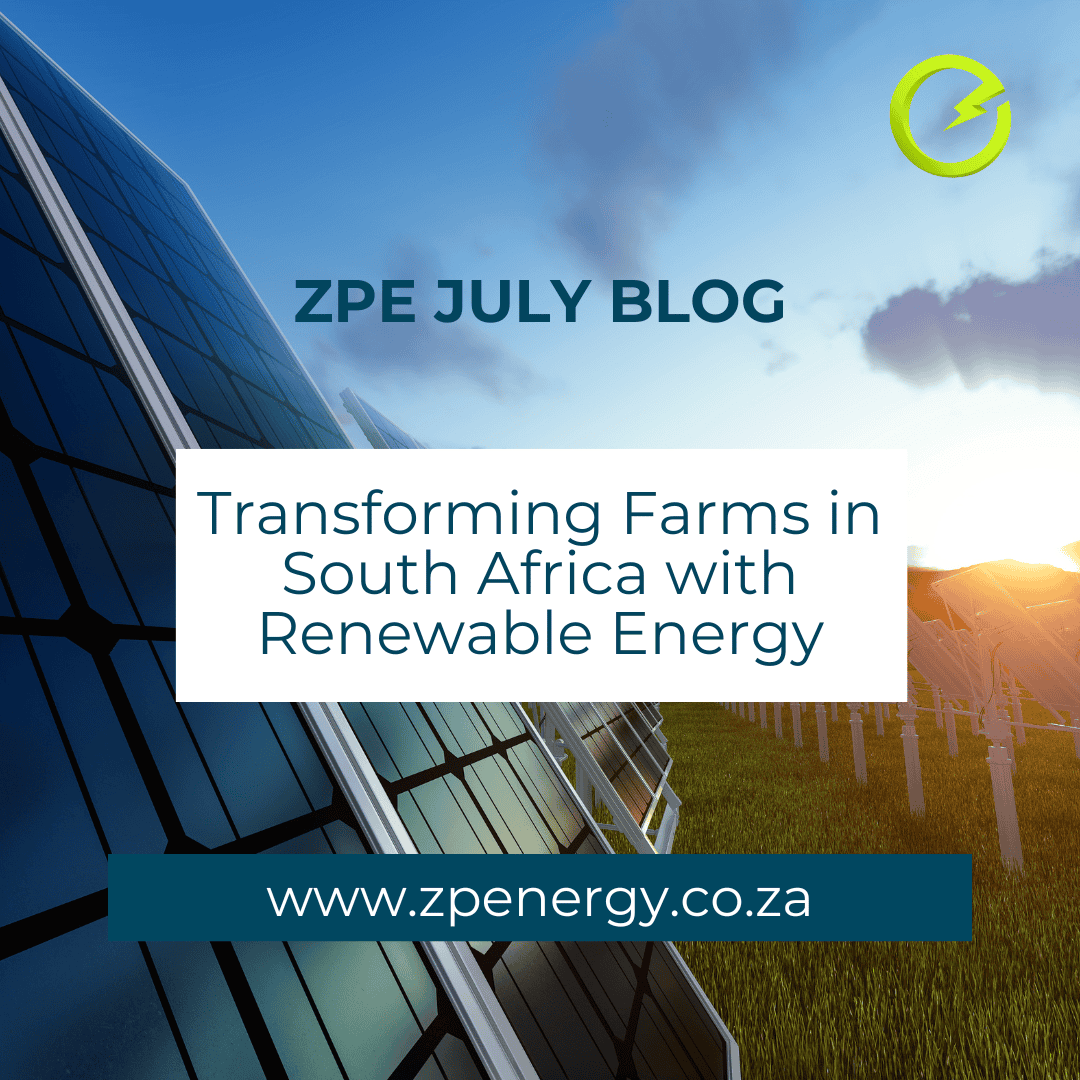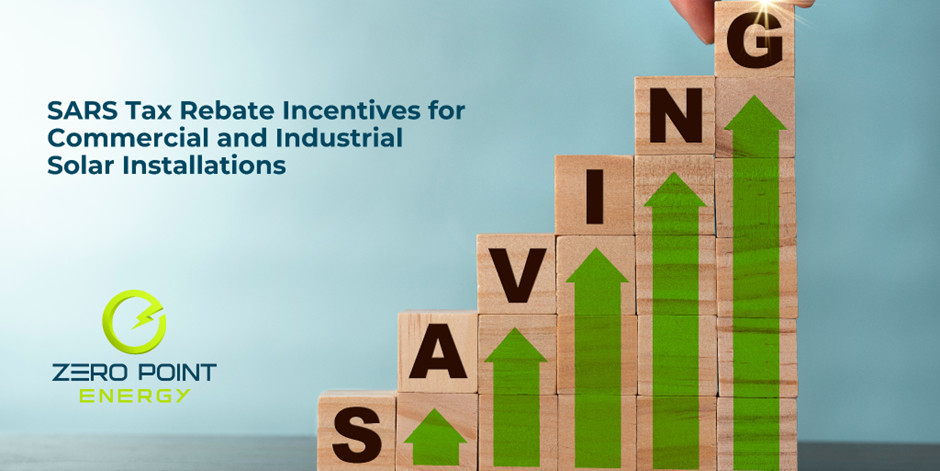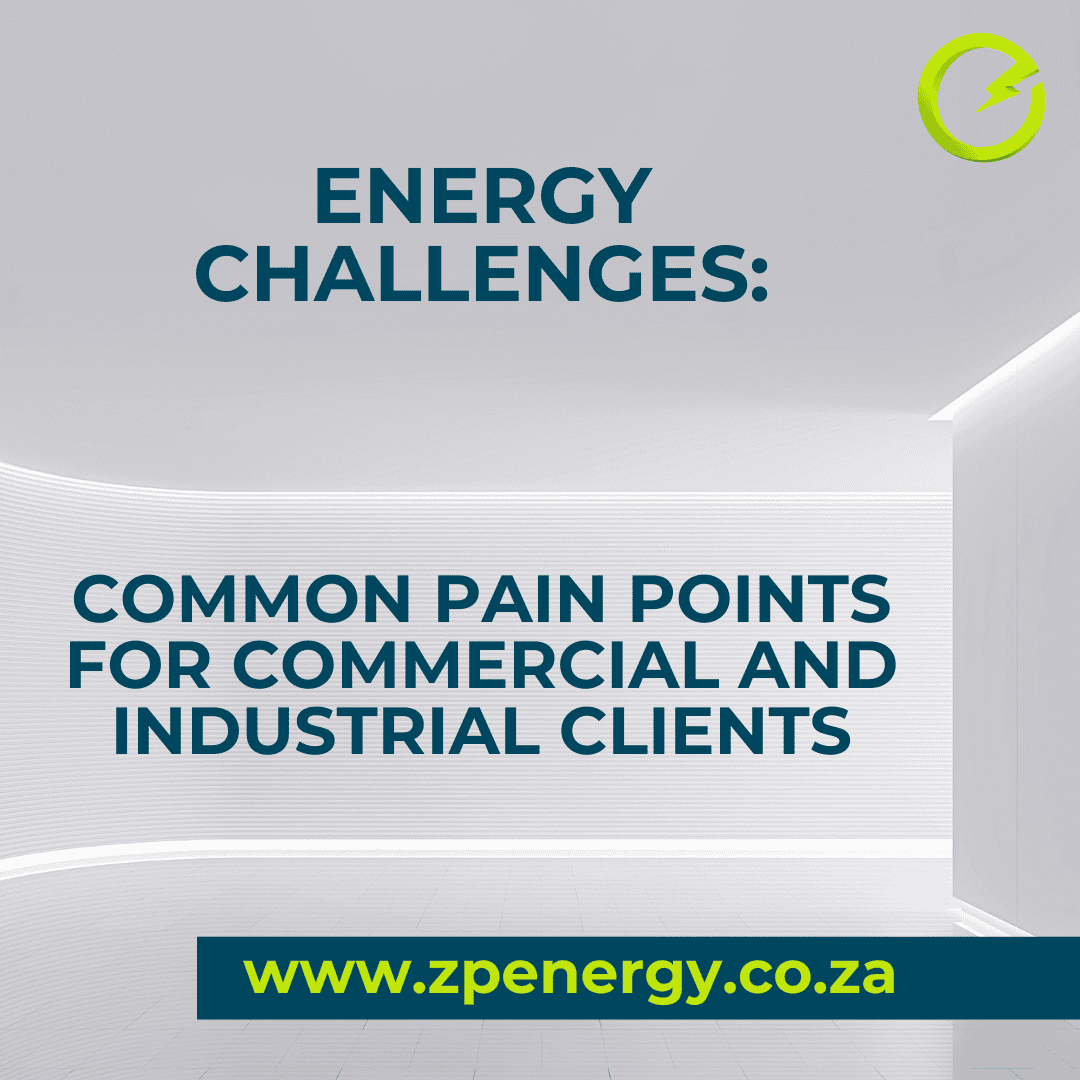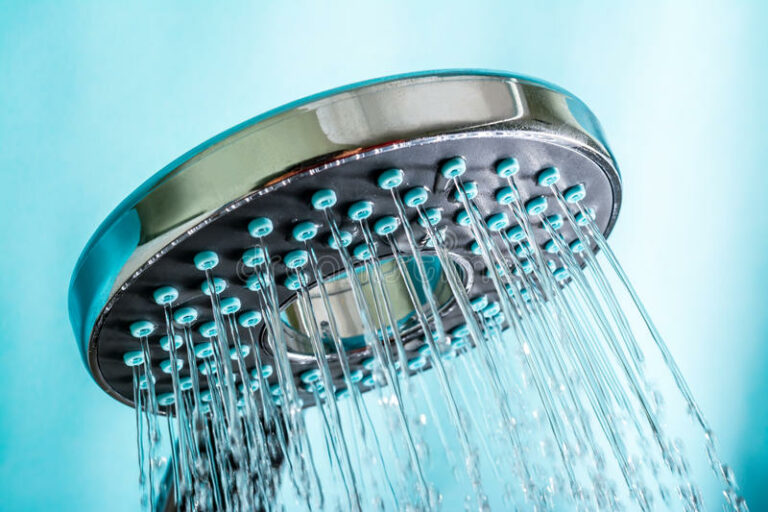
A Comparison of PV, Solar Thermal, Gas and Heat Pump for Domestic Water Heating
Many domestic consumers are turning to renewable energy technology for their water heating needs. Several factors are behind this transition, including the cost of electricity, the instability of the national grid and the growing awareness about the need for sustainable living. The national building regulations also require that at least 50% of water heating be done with something other than an electrical element.
As with many products on the market, however, you can find widely contradicting claims with regards to the different technologies. In this article, we shed some light on the main water-heating technologies and the savings you can achieve with each of them.
Instantaneous Gas Water Heaters
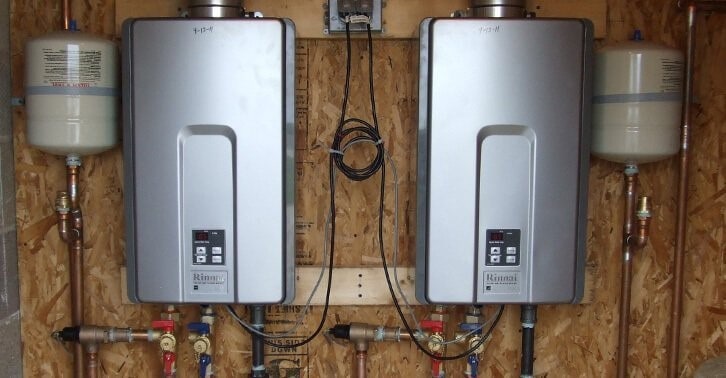
Source: Service Champions
This option uses LPG to heat water instantaneously. There is therefore no geyser or hot water storage tank needed. 1kg of LPG “contains” 13.6kWh of energy and therefore can produce 11.5kWh of thermal energy if the gas heater has an average efficiency of 85%.
Solar PV Water-Heating Element
This option uses solar electric panels (PV panels) to power an electrical heating element. An electrical element is close to 100% efficient, meaning a 1kW element will consume 1kW of electricity to produce 1kW of thermal output. This power comes from a PV panel.
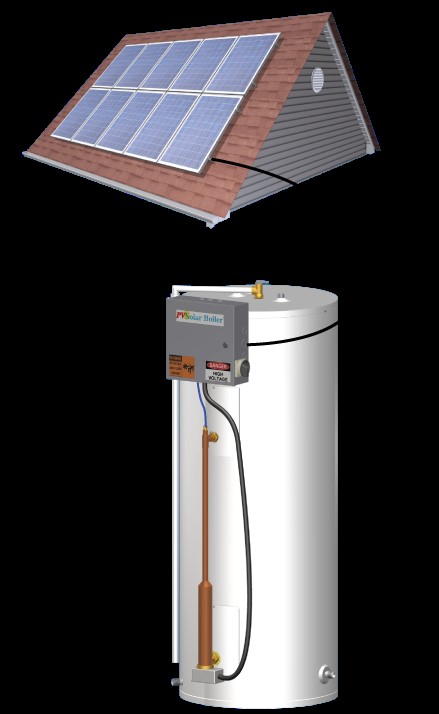
Source: Thermo Dynamics Ltd.
PV panels must be installed facing north and at a horizontal angle equal to the latitude of the location and it is critical that there is no shading on the panel. Shading as little as 2% of the panel surface can result in more than 50% panel output reduction.
The efficiency of the PV panels is around 17% (under lab conditions with the cell at 25°C). In real life, with the sun shining on the cell, it will heat up and cause a decrease in output power of about 8% (0.4%/°C with 20°C nominal operating cell temperature (NOCT)).
Panel ageing will typically result in a maximum degradation of 2.5% in the first year and up to 10% in 10 years. Next, you need a maximum power point tracking (MPPT) to ensure optimal power transfer from the panels to the element. A very good MPPT is typically around 95% efficient and therefore you lose another 5% of the available power.
Solar Thermal Water Heaters
These water heaters use the radiation from the sun to generate heat. The size of the solar panel will determine how much energy can be collected from the sun. For example, if we have a 2.4m2 solar panel connected to a geyser, this might give us 60°C water at the end of a warm sunny day but, during cooler days with less sunshine, it might only be able to heat the water to 35°C. The solar controller will then use Eskom to heat the water to 60°C. If we have a solar panel that is only half the size (1.2m2), we would only get out half the energy and an electrical element will need to do the rest.
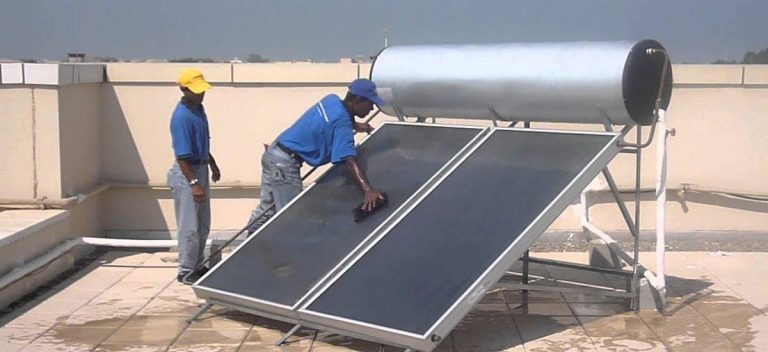
Source: UCUSA
A good quality flat plate solar thermal collector has an efficiency of around 73%. The output of a solar thermal collector de-rate based on the temperature difference between the water in the collector and the ambient temperature. Working on an average temperature delta of 17.5°C (heating water from 15°C to 60°C @20°C ambient) will give about a 10% reduction in output. Piping thermal losses on the insulated pipes connecting the solar panel to the geyser is about 10W/m.
Domestic Hot Water Heat Pump
These use a small amount of electricity to extract a lot of energy from the surrounding air. A heat pump also uses the sun’s energy but only indirectly, so it can work day and night, winter and summer. The efficiency of a heat pump is called coefficient of performance (COP). A COP value of 4 means that the heat pump produces four times as much thermal energy as what it uses electrically i.e. a 75% saving on the water heating bill.
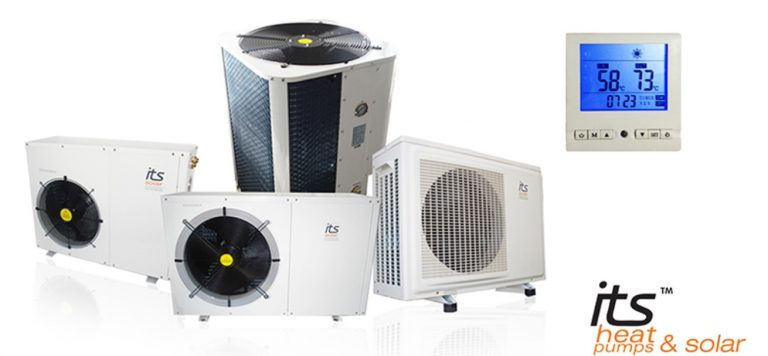
Source: ITS Heatpumps
Unfortunately, the COP of a heat pump is dependent on the ambient temperature and the water temperature and so, in a practical domestic hot water system using a well-designed heat pump, a realistic annual COP value is 3 i.e. a 66% saving on the water heating bill.
A Practical Example
A family of 4 that uses water moderately goes through about 200L of hot water per day. To heat 200L of water from 15°C to 60°C requires 10.4kWh. The standing loss of a B-rated 200L tank is 1.6kWh/day in the lab, but with installation piping included, it is typically around 3.6kWh/day. Therefore, the total energy requirement for this family’s hot water is 14kWh/day. If they are paying R2/kWh for electricity, their water heating costs them R840/month. Assuming that water heating typically makes up 50% of the total electrical bill, we are looking here at a family that spends about R1680 per month on electricity.
Let’s now look at what the different water heating technologies can do for them:
An instantaneous gas water heater would save them the standing losses on the geyser. They will therefore only need 10.4kWh of thermal energy per day. With a 85% average efficiency unit they will burn 0.9kg of gas per day. At R23/kg the monthly cost will be R624. Assuming a 10% annual electrical tariff increase as well as a 10% annual LPG price increase they will save R16278 over the next 5 years on their water heating bill.
Gas water heating will save R16278 over the next 5 years on their water heating bill
A solar PV water heating element system installed on a 200L geyser typically consists of 3 x 330W or 4 x 330W PV panels. If they are perfectly facing, we should in theory be able to get a maximum of about 5 hours of 990W out of the 3 x 330W panels (Annual average. Winter you will have less because the sunlight hours are less, and in summer, you will have more. This is unfortunately mismatched for when people use the most hot water). We therefore have a theoretical maximum of 4.95kWh but with panel temperature de-rating, first year ageing and MPPT losses the power available to the element will be around 4.2kWh/day.
The element controller will use Eskom to do the rest of the work and get the tank to 60°C (SANS 151 requires water to be stored at 60°C for Legionella disease prevention). The monthly Eskom bill for getting this system to 60°C will be R588. Assuming a 10% annual electrical tariff increase they will save R18731 over the next 5 years on their water heating bill.
For the 4 x 330W panel system the power available to the element will be around 5.6kWh/day. The monthly Eskom bill for getting this system to 60°C will be R504. Assuming a 10% annual electrical tariff increase they will save R24974 over the next 5 years on their water heating bill. The 3 x 330W panel system requires a north facing, unshaded roof space of 6m2 and the 4 x 330W panel system 8m2.
A large solar PV water heating element will save R24974 over the next 5 years on their water heating bill
A solar thermal water heater system typically installed on a 200L geyser consist of a 2.4m2 solar panel (flat plate or equivalent evacuated tube). From the TUV Rheinland test reports of the ITS 2.4m2 flat plate solar collector, it can be seen that it will give a thermal output of around 8.7kWh for the same 5 hours of annual average usable sunlight per day as used with the PV example above. De-rating this for differential temperature losses and 10m of installation piping we are left with 7.3kWh/day. The monthly Eskom bill for getting this system to 60°C will therefore be R402. Assuming a 10% annual electrical tariff increase they will save R32556 over the next 5 years on their water heating bill.
A solar thermal water heating system will save R32556 over the next 5 years on their water heating bill
A domestic hot water heat pump working at average South-African ambient temperatures will conservatively provide an annual average saving of 66% on whatever system it is connected to. The monthly Eskom bill for keeping this system at 60°C will therefore be R280. Assuming a 10% annual electrical tariff increase they will save R41609 over the next 5 years on their water heating bill.
A domestic hot water heat pump water heating system will save R41609 over the next 5 years on their water heating bill
Conclusions
The graphs below show the saving the different systems can provide for 150L, 200L and 300L hot water usage per day:
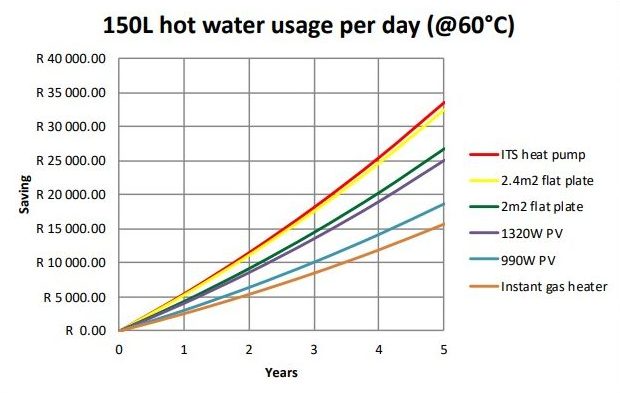

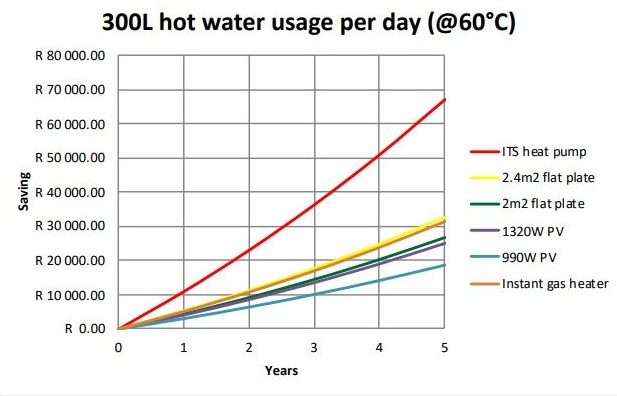
An instantaneous gas water heater, in our view, makes sense in places where there is no electricity available. The completed installed cost of a proper unit is only a few thousand less than a flat plate with geyser and the saving from the solar system is almost double for 200L hot water usage. Gas water heating does not care about Eskom load-shedding, but do keep in mind that we have had gas supply shortages and that will leave you with cold water.
With storage water heaters, load-shedding is normally not a problem unless the outage lasts for more than a day since the water can stay warm in the tank for very long and re-heating using an electrical element or heat pump takes only a few hours. If you use 200L of 60°C water per day, 9kg of LPG will last you only 10 days and so you will have to think about the gas supply and logistics.
Instantaneous gas water heaters are also great backup for solar water heaters installed in locations with no electrical grid connection. The gas heater in such an installation will only cover the shortfall of the solar water heating system.
A solar PV water heating element, in our view, makes sense only when the geyser is situated far from the solar panels like in a multi-story building. The thermal losses in the piping of the normal solar thermal system in such an installation will reduce the output to such a level that the PV heating could be more cost effective. For standard installations where the geyser is within say 10m from the solar panel, the flat plate system will provide a much better return on investment.
A 3 x 330W installation is slightly more expensive than a 2.4m2 flat plate installation, but the flat plate will save R14k more over 5 years, in our example. Most solar PV element systems we see installed are completely undersized and are done by people who are simply trying to get away with the cheapest possible option.
A PV thermal system that will give you almost the same output power as a 2.4m2 flat plate will need 5 x 330W PV panels resulting in an expensive system that requires 10m2 of north-facing non-shaded roof space. Should the client at some stage want to install a PV electrical system to become more independent from Eskom, they will most likely not have enough roof space left.
Another great concern with PV element systems is the current lack of regulation of the installations and equipment. PV element systems operate at lethal DC voltages and installing one cheaply and poorly could potentially be deadly.
A solar thermal water heater system will provide a great return on investment, but it is important that it is installed correctly. Unfortunately, we are also seeing installers that are pushed for price going for undersized systems. If we for example look at the 200L system example using an ITS 2m2 flat plate collector your saving will be R26758 over 5 years. By going for the slightly bigger 2.4m2 flat plate, your installation cost will increase by about R400 but your saving over 5 years will increase by R5797 to R32556. A 2.4m2 flat plate is also by no means too big for a 150L system and so a 2m2 flat plate only makes sense for bigger systems where you require multiple panels.
A domestic hot water heat pump will provide the best saving in this example. An ITS 4.7kW heat pump installation will cost you about R5k more than an 2.4m2 flat plate installation but will result in a R9k better saving after 5 years.
A solar system can provide a bigger saving than a heat pump but for that the solar system needs to be oversized and water usage patterns needs to be adjusted. Typically you need double the volume of hot water that what you would need for a normal electrical geyser or a heat pump system. In coastal areas like Cape Town however the winter irradiation is much lower than summer irradiation. This means that even if your solar system was sized for 100% of your solar usage in summer you will have only about half the thermal output you need in the winter and the electrical element would need to do the rest. Winter is also when people use the most hot water and so a heat pump would almost always be a better solution in areas like Cape Town.
Solar PV and thermal systems can only “harvest” energy while the sun is shining. The system sizing is done to give you a certain percentage of your energy requirement per day which is based on how many liters of hot water you use per day. If some friends visit and stay over the extra hot water required will need to be heated using Eskom. With a heat pump system the heat pump will simply continue heating more water as you use more while providing around 66% saving on whatever you use.
To get the most out of solar PV and solar thermal heating systems also require you to use it correctly. If you then use most of the hot water in the evening, you will need Eskom to have hot water in the morning. If you are not using a lot of water in the morning, the solar system is heating a tank that is already almost on temperature and so you will not use all the energy available from your solar system during the day. With a heat pump, it makes no real difference when and how you use the water.
*This article was reproduced with permission from ITS Solar – South Africa’s Leading Heat Pump Supplier
Contact us today to assess, design and install your next energy efficient water heating and integrated renewable energy solutions:

Landline: +2710 593 4449 | Whatsapp: +27605218388 | info@zpenergy.co.za | TW & IG: @zeropointSA | www.zpenergy.co.za
Zero Point Energy (Pty) Ltd is an accredited partner, installer and system integrator of the ITS range of industrial, domestic and pool heat pumps. Combined with our strong engineering and project management track record to date, this partnership enhances our value proposition to clients by allowing us to further optimise and broaden our integrated sustainability solutions offering.
We are also a proudly South African sustainable engineering company that provides professional engineering consulting & turn-key solutions in the areas of energy efficiency, renewable energy, off-grid and energy storage solutions, water efficiency and responsible waste management. The company is a 100% black youth-owned, 30% black female-owned company achieving a Level 1 BBBEE Contributor status, and has a passion to transform the energy industry without compromising on safety, quality and client satisfaction. Learn more about the company’s team here
#heatpumps #energyefficiency #energysaving #costsaving #sustainability #greenenergy #renewableenergy #solarpower
